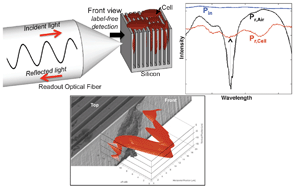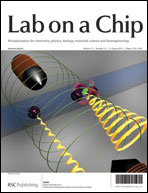We demonstrate high aspect-ratio photonic crystals that could serve as three-dimensional (3D) microincubators for cell culture and also provide label-free optical detection of the cells. The investigated microstructures, fabricated by electrochemical micromachining of standard silicon wafers, consist of periodic arrays of silicon walls separated by narrow deeply etched air-gaps (50 μm high and 5 μm wide) and feature the typical spectral properties of photonic crystals in the wavelength range 1.0–1.7 μm: their spectral reflectivity is characterized by wavelength regions where reflectivity is high (photonic bandgaps), separated by narrow wavelength regions where reflectivity is very low. In this work, we show that the presence of cells, grown inside the gaps, strongly affects light propagation across the photonic crystal and, therefore, its spectral reflectivity. Exploiting a label-free optical detection method, based on a fiberoptic setup, we are able to probe the extension of cells adherent to the vertical silicon walls with a non-invasive direct testing. In particular, the intensity ratio at two wavelengths is the experimental parameter that can be well correlated to the cell spreading on the silicon wall inside the gaps.

You have access to this article
 Please wait while we load your content...
Something went wrong. Try again?
Please wait while we load your content...
Something went wrong. Try again?


 Please wait while we load your content...
Please wait while we load your content...